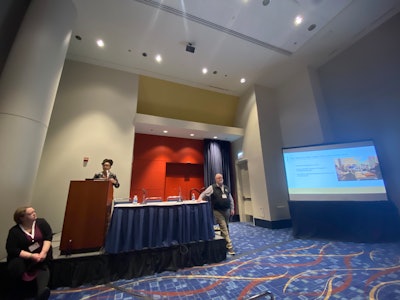 Educational leaders discuss how to partner with businesses on the third day of the Dream Conference.
Educational leaders discuss how to partner with businesses on the third day of the Dream Conference.
“Community colleges need to build a more dynamic understanding of local labor markets, embed students’ relationships to work and career ambitions into academic support systems, rather than see our institutions as simply a throughway,” said Dr. Karen A. Stout, president and CEO of ATD. “Fundamental to all of this is the need to develop strategies born out of active and collaborative partnership, not merely looking within our own spheres.”
Educators from a variety of community colleges shared how student success and sense of belonging is vital to meeting their local workforce needs, and how their unique geographic locations, demographic growth, and regional needs have influenced how they connect with big industry and small to mid-sized businesses.
At Columbus State Community College (CSCC) in central Ohio, CSCC President Dr. David T. Harrison has connected with Intel, one of the world’s largest semiconductor chip manufacturers. Intel announced in 2022 they would build two chip factories just outside of Columbus. Harrison said that Intel has remained adamant that the 3,000 new jobs these factories will create are technical level, for those with associate degrees.
“Almost every Intel leader I meet is an associate degree graduate that started out as a technician. In addition to focusing on associate degree earners, they have an explicitly stated emphasis on diversity and equity,” said Harrison.
While Harrison said CSCC’s academic supports moved the needle on student success and completion, their progress plateaued until they began to build out non-academic supports, including the construction of a grocery store on campus and creating housing and transportation partnerships. CSCC has shared these lessons, along with student data, with employers. And they are listening, Harrison said.
“Employers are leaning in and learning about our students and their lifestyles. In the same way so many of us are adopting practices for holistic student support, those same supports are required in the workplace as well, and employers are starting to understand that,” said Harrison.
In rural Louisiana, workforce needs look very different, said Dr. Nancee Sorenson, chancellor of Louisiana State University Eunice (LSUE).
“We are surrounded by rice fields and crawfish ponds,” said Sorenson.
A $1 million grant from the Delta Regional Authority, a federal-state partnership improving the quality of life in the Mississippi Delta, has allowed LSUE to go back to its agrarian roots. The college has transformed its science building into a STEAM building—Science, Technology, Engineering, Agriculture and Mathematics.
LSUE partnered with local farmers and ranchers, creating certificate programs to build a more robust greater agricultural workforce. LSUE has also connected agriculture with technology through a free six-month program that teaches students how to use drone technology to supervise plant growth and wellness.
“We have a mobile tech unit, where we’ll be able to go out to farms, crawfish, rice, and sugarcane producers and teach this [drone] technology to their workers and businesspeople,” said Sorenson. “Our commitment is to make sure rural communities survive and thrive. They are essential to the lifeblood of our area and very, very important to our citizens.”
 (left to right) Jan Miller from Bay Mills Community College, Karen Colbert from Keweenaw Bay Ojibwa Community College, and Earle Crosswait from Saginaw Chippewa Tribal College discuss how Carnegie Math Pathways courses have helped their students.
(left to right) Jan Miller from Bay Mills Community College, Karen Colbert from Keweenaw Bay Ojibwa Community College, and Earle Crosswait from Saginaw Chippewa Tribal College discuss how Carnegie Math Pathways courses have helped their students.
Karon Klipple, director of Carnegie Math Pathways, said, “math was the single greatest barrier to college completion. What sets this program apart is the focus on and investment in faculty.”
In 2017, Carnegie Math Pathways received funding from the federal Department of Education to launch the program with Tribal Colleges and Universities (TCUs) like KBOCC. The program connects math faculty at these unique institutions, offering intentional and rare chances to learn about and work with each other. This is important, said Colbert, as there are over 500 distinct languages and cultural experiences among the tribal nations of the U.S.
“In general, TCUs have to maintain, preserve, and restore the historical languages and cultural traditions [of Native Americans,] and we have to do that with college education. Aligning what makes math an indigenous course can be difficult,” said Colbert. “Carnegie allows us to be unique and learn about each other.”
TCU Statway and Quantway instructors shared how these programs have increased the confidence in their students. By being able to meet with each other and brainstorm creative ways to involve cultural practices in math instruction, TCU math faculty have made math, and the careers that come with it, accessible to the communities they serve.
“Success rates have grown from 40 to 60% on average. Students are meeting college math requirements in less time, getting them onto their degree programs,” said Klipple. “Most importantly, what we’ve seen is the students are changing their perception of themselves. Their changing relationship and confidence and ability to do math is the most powerful outcome.”
Liann Herder can be reached at [email protected].






















